Blog Archives
Mudlarks building nest of mud
A few weeks ago, I watched a pair of Mudlarks building their nest. Mudlarks get their name from their construction of nests made of mud and reeds. Despite their name, Mudlarks are not larks. Another name for them is Magpie-larks — but they’re not Magpies either! Yet another name for them is Peewees, which is an imitation of the noise they make: pee-wee, pee-wee.
Building a good nest takes a lot of patience and skill. The birds use their beaks to pile globules of mud on top of each other to form a bowl, increasing the circumference of the bowl with each layer. Every now and then, the birds sit in the growing nest and wiggle their bodies around to smooth out the inside and make sure the nest is the right size and shape. Watch this video to see the nest-building:
The birds collect mud and reeds from a nearby river or lake. Here’s a pair of them (male and female) collecting reeds at Manly Dam in NSW, Australia:
Here’s the female sitting in the nest, making sure it’s the right size and shape:

Here’s a still shot of the male gathering mud and reeds:
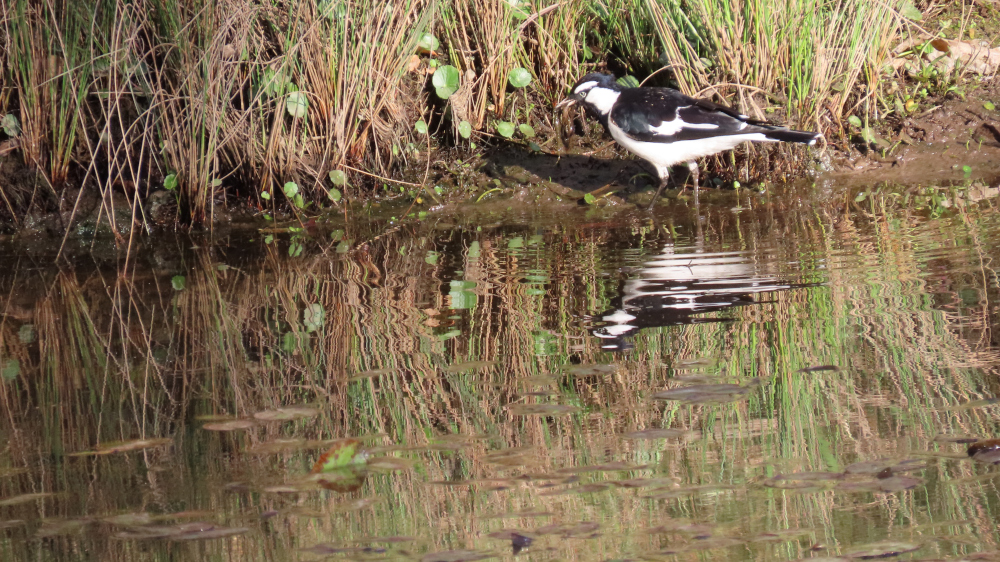
Common name: Magpie-lark, also called a Peewee or a Mudlark
Scientific name: Grallina cyanoleuca
Approximate length: 30 cm
Date spotted: 18 September 2025 (spring)
Location: Manly Dam National Park, New South Wales, Australia
Alas, butcherbirds nest abandoned when tree fern sprouted
In my previous post, I wrote about a pair of Grey Butcherbirds that had built their nest in a tree fern below our house. The problem with tree ferns is that they sprout new fronds from the centre of the trunk, exactly where the birds had built their nest.
The photos of the nest in my earlier post were taken on the 18th of September. Just a few days later, the tree fern did indeed sprout a new frond, putting the nest at an uncomfortable angle. Still, the butcherbirds persevered. This photo, taken on the 25th of September shows one of the birds sitting determinedly on a very slanted nest, which presumably still contained the three eggs:
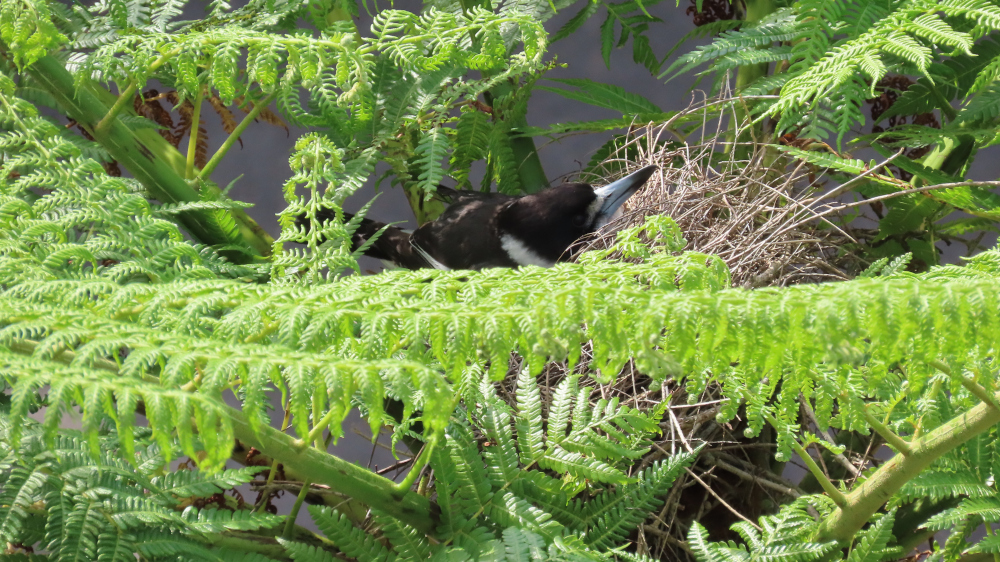
Just a day later, the birds had abandoned the nest. I don’t know if the eggs were still in the nest. The tree fern is way too high for me to go up and take a look:

By yesterday, the 5th of October, the new fern frond had pushed the nest to the top of the canopy:

Never mind little butcherbirds, there’s still plenty of time left this season to try again. Or next year perhaps.
Perhaps they’ll have learned something about real estate from this experience. Grey Butcherbirds live for around 20 years, so there’s plenty of time for learning!
Common name: Grey Butcherbird
Scientific name: Cracticus torquatus
Approximate length: 30 cm
Date spotted: 18 September to 5 October 2025 (spring)
Location: Allambie Heights, NSW, Australia
Did the big scary lizard make the Mudlarks abandon their nest?
For a few weeks now, I’ve been watching a pair of Mudlarks building their nest. In fact, they’ve built two nests. The first one looked good and solid from my vantage point, far away and down at ground level. But a couple of days after they’d finished it, they abandoned it and started a new one higher up in the same tree.
Mudlarks, also called Magpie-larks or Peewees, build neat round nests that are basically bowls made of mud. This video shows a male Mudlark collecting mud and reeds at the water’s edge. When he has a good collection, he flies off towards the nest that he and his mate are constructing. As the bird flies, a couple of Kookaburras start cackling, and one of the Mudlarks gives its distinctive call: “pee-wee pee-wee pee-wee”.
Here’s the male Mudlark on mud collection duty:

The next video shows the first nest under construction. The bird prods and pushes mud into the walls of the nest, then sits flat and wiggles its tail end to shape the nest.
As well as building walls, nest construction also involves sitting on the nest and wiggling back and forth to get the shape right:

The nest was looking good, I thought. But several days later, a decision is made. The birds abandon their first attempt and start a new nest, higher up in the same tree:
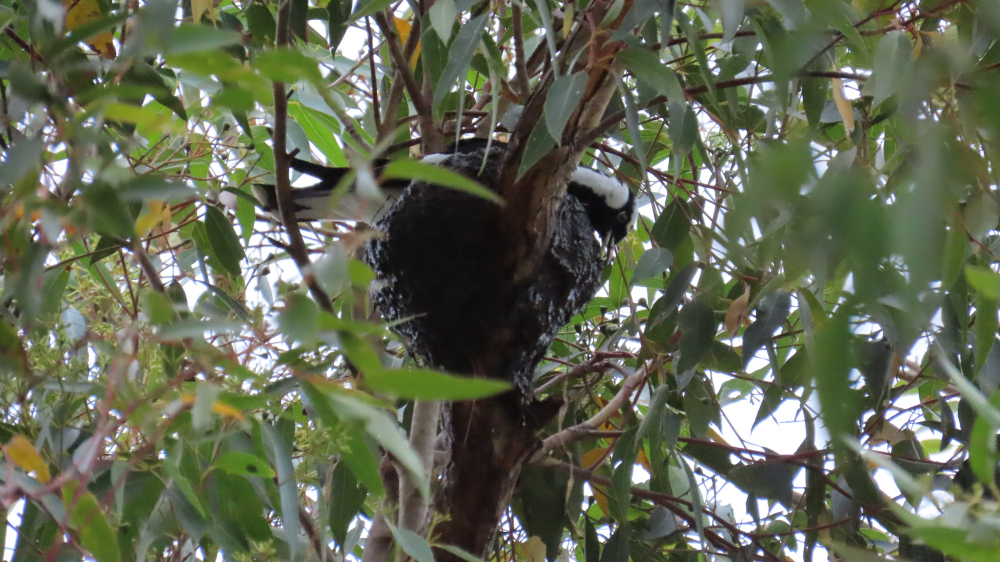
They’ve chosen a lovely spot, at the edge of Manly Dam. The next video shows one of the birds building the second nest. The second bird arrives with a beak-ful of mud, and takes over construction. The video then zooms out and in again to show the first nest on a lower branch, then zooms out further to show the dam and some of the neighbours (a Little Black Cormorant and a Great Egret).
Aside from the occasional noisy cockatoo, the neighbours are quiet for the most part — like this Great Egret:

And a few water dragons:

But the park does get quite busy over the weekend. Families hold picnics nearby, and children paddle in canoes. Perhaps the birds moved higher to avoid the weekend disturbance.
Perhaps the first nest didn’t meet quality assurance checks. Or perhaps the two parents-to-be spotted the large, scary intruder in the neighbourhood: a Lace Monitor lizard. I took this video of the lizard prowling around the tree where both nests are. Lace Monitors eat eggs and baby birds, and are very good at climbing trees. The Mudlarks’ second nest is higher in the tree and on thinner branches, which would make it much more difficult for the lizard to reach.
Lace Monitors are the second-largest lizards in Australia. They measure 1.5 to 2 metres long — longer than I am tall, and their hands are as big as mine! Here’s a close-up of the Lace Monitor on the move:
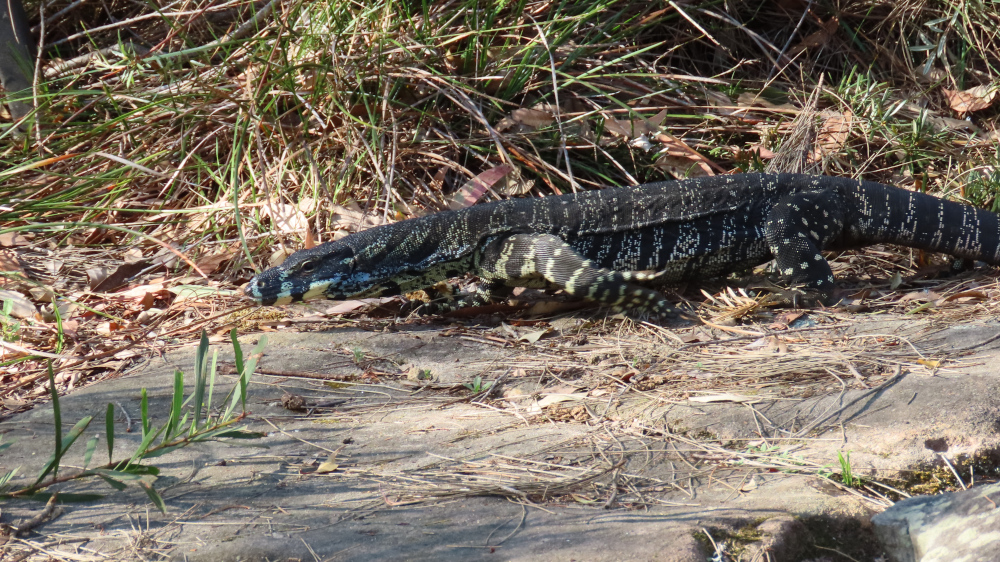
When I got too close with my camera, the lizard crouched down and went into stealth mode:

The Mudlarks are still sitting happily on their new nest. Here’s the male:

And here’s the female:
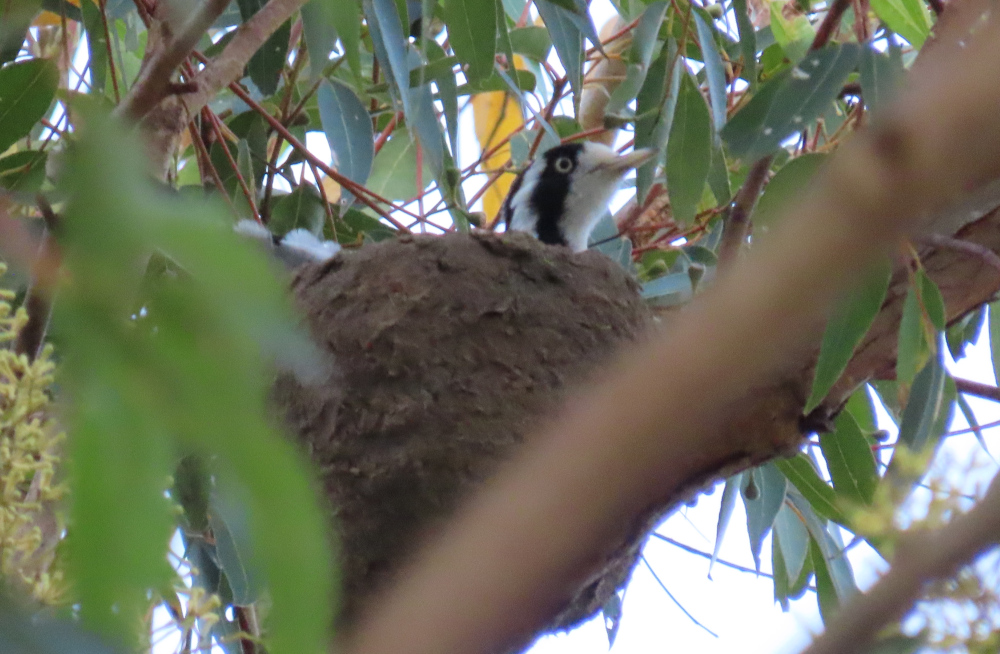
Good luck to them and their new family!
Common name: Magpie-lark, also called a Peewee or a Mudlark
Scientific name: Grallina cyanoleuca
Approximate length: 30 cm
Date spotted: August to September 2024 (summer)
Location: Manly Dam National Park, New South Wales, Australia
Magpie-lark nest with chicks
A couple of days ago, I spotted a Magpie-lark having a quick cicada snack. Today, back in the same area of Manly Dam, there was more activity in the Magpie-lark community. It turns out that the birds have a nest nearby, and the adults are busily feeding the chicks.
In this video, the chicks’ heads pop up when the adult arrives to feed them. When the adult leaves, the babies stretch the necks, begging for more.
As you can tell, the nest was quite far away from my vantage point, and my camera’s zooming powers are stretched to the utmost. Still, you can see what’s happening.
Here’s a still shot of the nest with an adult Magpie-lark peering down into it. The adult is a female, as it has a white throat. You can see the white underbelly of the bird towards the left, the black wings above, and then, on the right of the branch, the black-and-white head with the bird’s eye just above the rim of the nest:
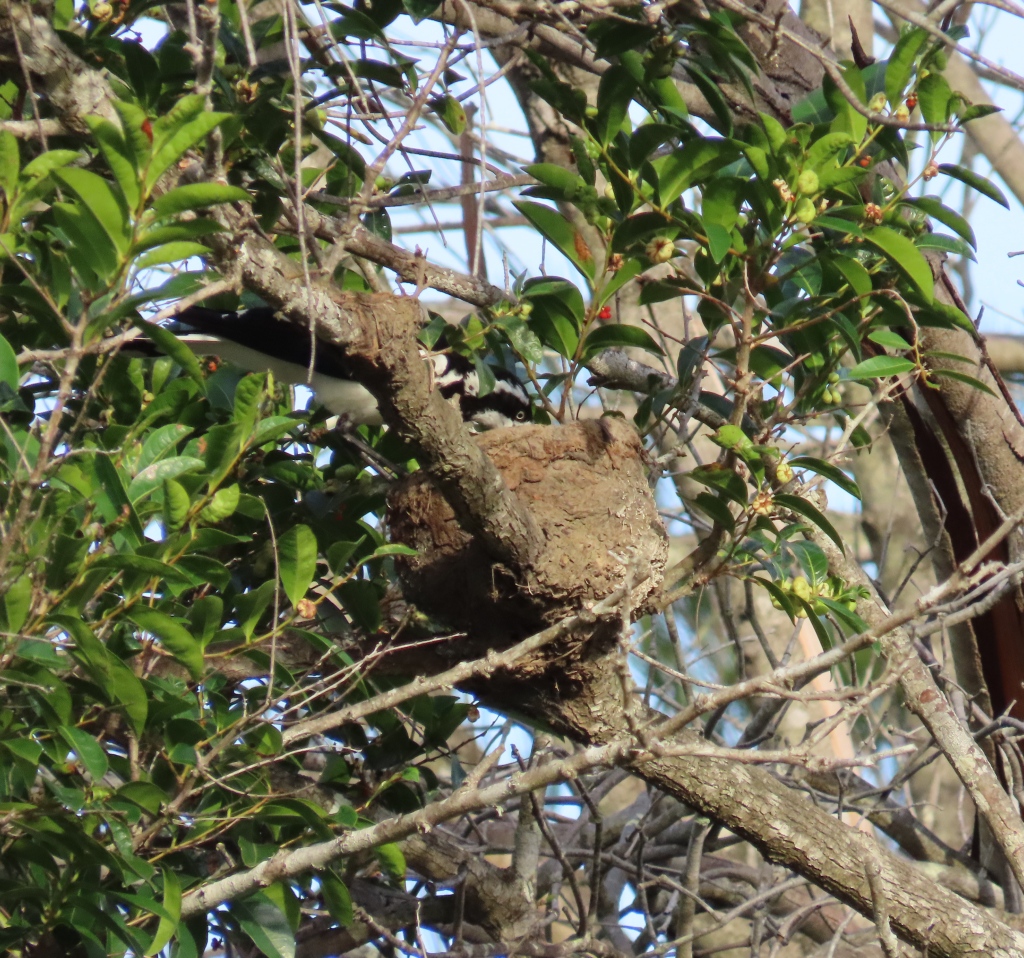
Gathering food and feeding babies is hard work. The adults often take a breather within sight of the nest, but out of sight of the babies, so that the babies don’t squawk for food. Here’s a male adult (black throat) at top right of the photo, with the nest near the bottom left:
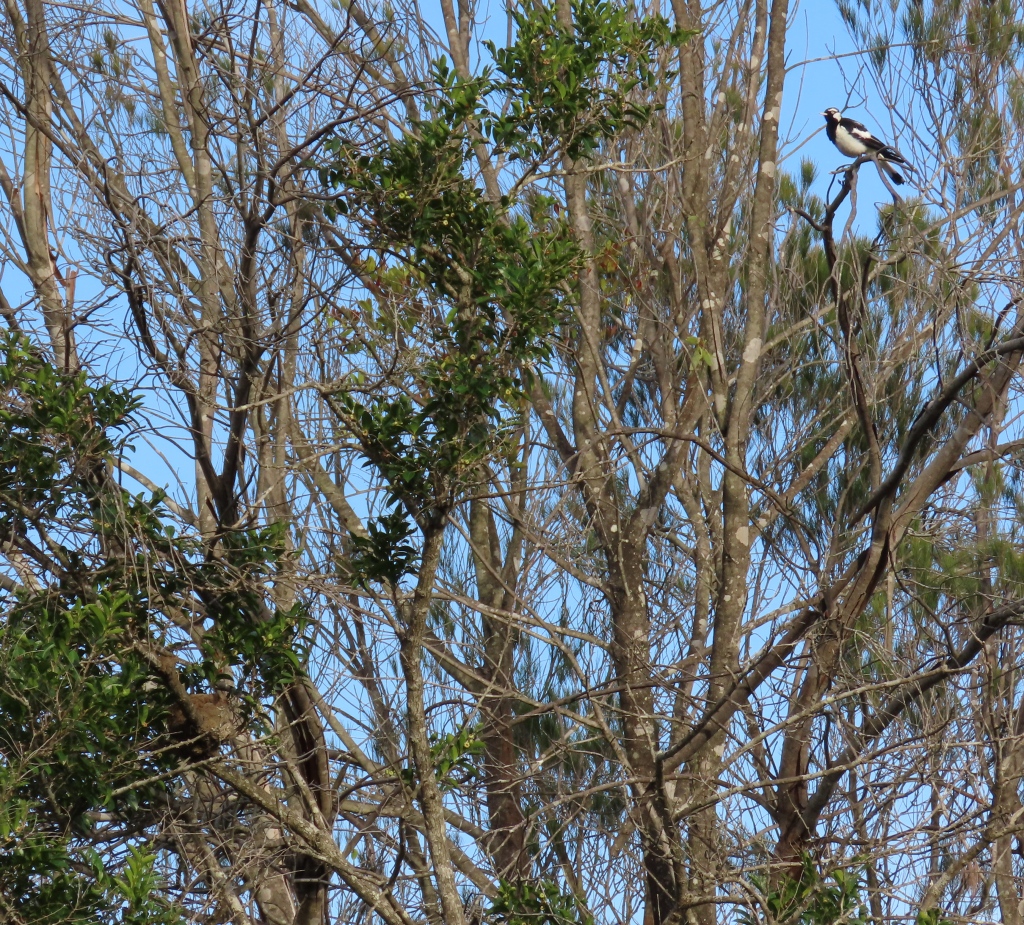
Here’s a closeup of the adult taking a breather:
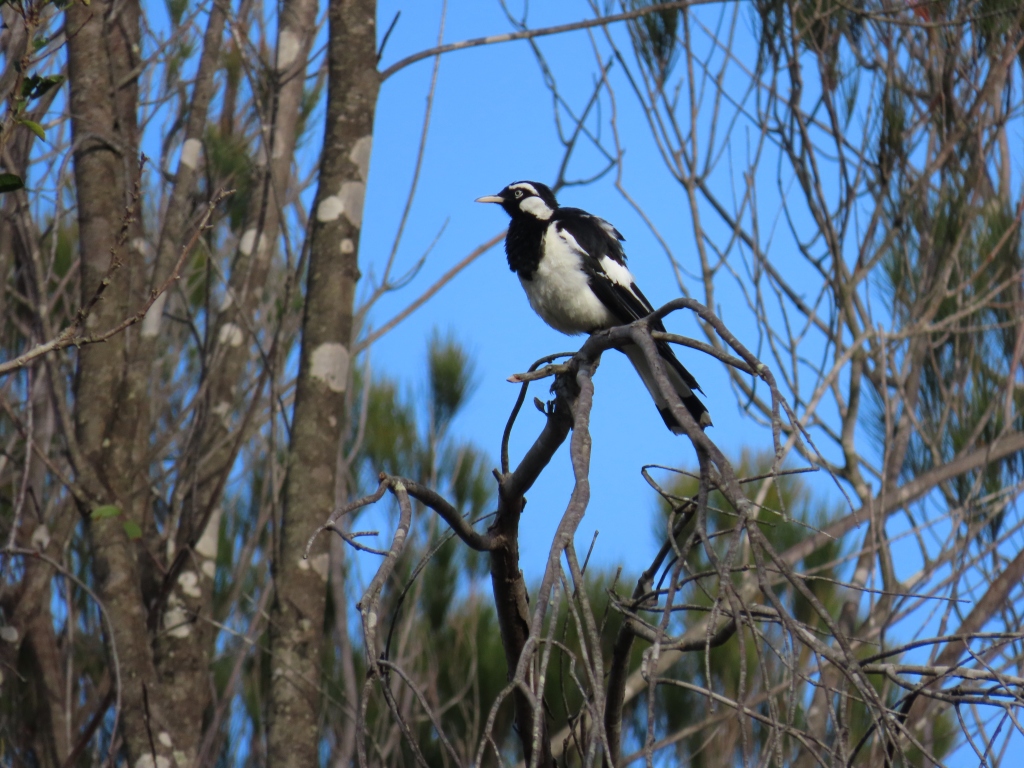
Common name: Magpie-lark, also called a Peewee or a Mudlark
Scientific name: Grallina cyanoleuca
Approximate length: 30 cm
Date spotted: 7 January 2024 (summer)
Location: Manly Dam National Park, New South Wales, Australia: 33°46’35.5″S 151°14’50.3″E
Pardalotes nesting on a Sydney beach
Pardalotes are unusual in that they build their nests underground, usually at around ankle height. This morning I spotted a couple of the birds flitting around a grassy bank on a beach in Sydney Harbour. With a bit of patience and the benefit of my camera’s super zoom, I was able to see the birds going in and out of their nesting tunnel.
The next video shows the male bird waiting on a tree branch until the coast is clear, then flitting off towards the nest:
Here’s the female, also checking for danger near the nest:
These are Spotted Pardalotes, also called Diamondbirds. They’re one of the smallest of Australian birds, at approximately 10 cm from head to tail. I’m often surprised at how unbothered they seem by my presence.
The female has a pale, faun-coloured chest. Her head and back are prettily dotted with spots, and her tail is aflame with red and yellow.

The male has an orange-yellow chest. The white stripes across its eyes are more pronounced than those of the femail, and there’s more black on the head and back, making the white spots stand out.
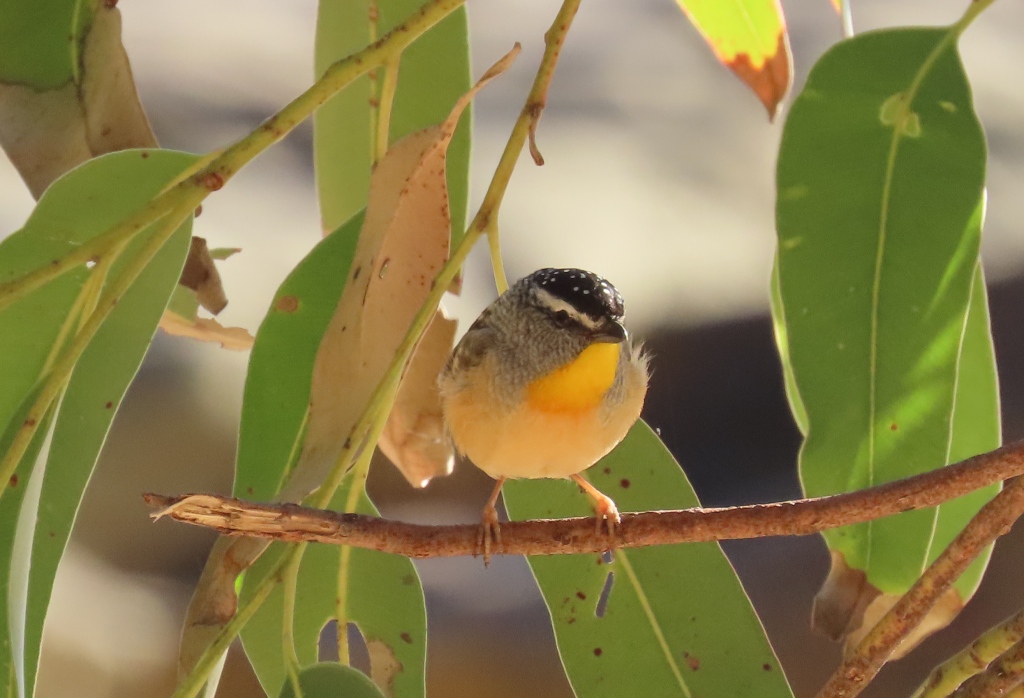
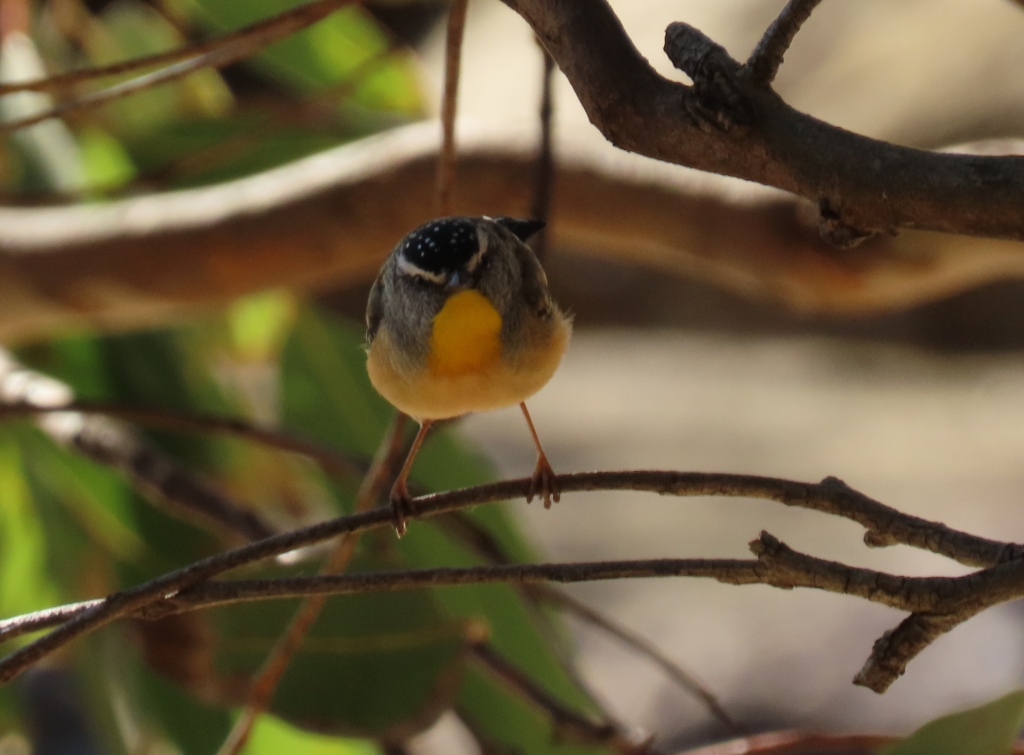
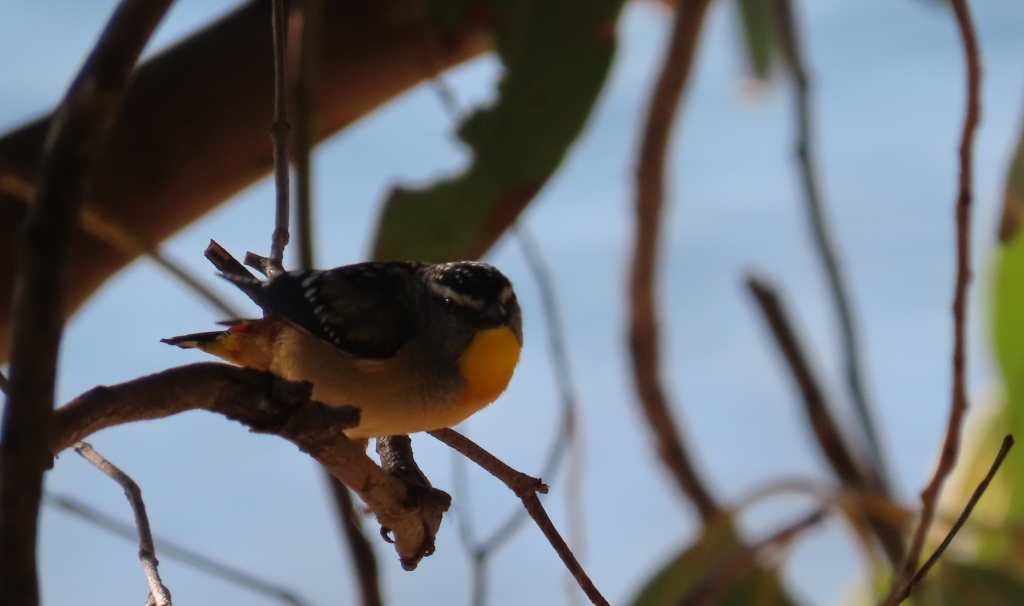
Common name: Spotted Pardalote or Diamondbird
Scientific name: Pardalotus punctatus
Approximate length: 10 cm
Date spotted: 29 July 2023 (winter)
Location: Reef Beach in Sydney Harbour




